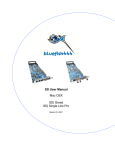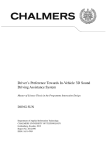Download Apple Loops Utility 3 User Manual (en)
Transcript
Apple Loops Utility 3 User Manual Copyright © 2009 Apple Inc. All rights reserved. Your rights to the software are governed by the accompanying software license agreement. The owner or authorized user of a valid copy of Final Cut Studio or Logic Studio software may reproduce this publication for the purpose of learning to use such software. No part of this publication may be reproduced or transmitted for commercial purposes, such as selling copies of this publication or for providing paid for support services. The Apple logo is a trademark of Apple Inc., registered in the U.S. and other countries. Use of the “keyboard” Apple logo (Shift-Option-K) for commercial purposes without the prior written consent of Apple may constitute trademark infringement and unfair competition in violation of federal and state laws. Every effort has been made to ensure that the information in this manual is accurate. Apple is not responsible for printing or clerical errors. Note: Because Apple frequently releases new versions and updates to its system software, applications, and Internet sites, images shown in this manual may be slightly different from what you see on your screen. Apple 1 Infinite Loop Cupertino, CA 95014 408-996-1010 www.apple.com Apple, the Apple logo, Logic, Logic Studio, Mac, and Soundtrack are trademarks of Apple Inc., registered in the U.S. and other countries. Finder is a trademark of Apple Inc. Other company and product names mentioned herein are trademarks of their respective companies. Mention of third-party products is for informational purposes only and constitutes neither an endorsement nor a recommendation. Apple assumes no responsibility with regard to the performance or use of these products. Contents Preface 5 5 6 6 Welcome to Apple Loops Utility About Apple Loops Utility About the Apple Loops Utility Documentation Additional Resources Chapter 1 7 7 14 14 16 17 18 18 Using Apple Loops Utility About the Apple Loops Utility Interface Opening Files in Apple Loops Utility Tagging Files in Apple Loops Utility Working with Transients Saving Changes to Files Removing Files from the Assets Drawer Apple Loops Utility Preferences Appendix 19 19 20 20 21 21 Apple Loops Utility Keyboard Shortcuts General and File Navigation Key and Scale Type Tagging Descriptor Tagging Transients 3 Preface Welcome to Apple Loops Utility Some audio files you use in Soundtrack Pro can include metadata called tags. Tags provide information about the audio recorded in a file. Apple Loops Utility is a companion application to Soundtrack Pro that you can use to view and manage tags in audio files. Soundtrack Pro uses tags in one of two ways: to help locate files using the Search feature in Soundtrack Pro, and to provide information that Soundtrack Pro uses when matching the file’s tempo and key to the project tempo and key—for the best possible playback quality. Both AIFF and WAV file formats can include tags. Libraries of audio files created for use with loop-based music software are usually tagged, and Soundtrack Pro recognizes the tags used in most popular file formats. This preface covers the following: • About Apple Loops Utility (p. 5) • About the Apple Loops Utility Documentation (p. 6) • Additional Resources (p. 6) About Apple Loops Utility You can add and change tags using Apple Loops Utility. You can also tag multiple files, a process known as batch tagging. Apple Loops Utility can read both AIFF and WAV file formats. When you save changes you make to either type of file, the file is saved as an AIFF file, the default file format for Soundtrack Pro. The set of tags you can work with using Apple Loops Utility includes all of the tags in WAV files tagged for use with Sony’s ACID music application, as well as additional tags. Tagged audio files can also contain information about transients. Transients indicate where beats occur in the file, and Soundtrack Pro uses transients to play back audio files at the highest level of quality. Apple Loops Utility can detect transients present in an audio file, and you can use Apple Loops Utility to add markers for additional transients and move them to new locations. 5 About the Apple Loops Utility Documentation The Apple Loops Utility User Manual (this document) describes the Apple Loops Utility application only. For information about Soundtrack Pro, see the Soundtrack Pro User Manual. • Apple Loops Utility User Manual: This comprehensive document describes the Apple Loops Utility interface, commands, and menus. • Soundtrack Pro User Manual: This is a comprehensive document that describes the Soundtrack Pro interface, commands, and menus, and gives step-by-step instructions for creating Soundtrack Pro projects and for accomplishing specific tasks. It is written for users of all levels of experience. Additional Resources Along with the documentation that comes with Apple Loops Utility, there are a variety of other resources you can use to find out more about Apple Loops Utility. Soundtrack Pro Website For general information and updates, as well as the latest news on Soundtrack Pro, go to: • http://www.apple.com/finalcutstudio/soundtrackpro Apple Service and Support Websites There are a number of Apple websites that you can visit to find additional information. For software updates and answers to the most frequently asked questions for all Apple products, go to the general Apple Support web page. You’ll also have access to product specifications, reference documentation, and Apple and third-party product technical articles. • http://www.apple.com/support For software updates, documentation, discussion forums, and answers to the most frequently asked questions for Soundtrack Pro, go to: • http://www.apple.com/support/soundtrackpro For discussion forums for all Apple products from around the world, where you can search for an answer, post your question, or answer other users’ questions, go to: • http://discussions.apple.com 6 Preface Welcome to Apple Loops Utility Using Apple Loops Utility 1 You use Apple Loops Utility to view and manage metadata tags in audio files. Some audio files you use in Soundtrack Pro include tags. Tags provide information about the audio recorded in a file. This chapter covers the following: • About the Apple Loops Utility Interface (p. 7) • Opening Files in Apple Loops Utility (p. 14) • Tagging Files in Apple Loops Utility (p. 14) • Working with Transients (p. 16) • Saving Changes to Files (p. 17) • Removing Files from the Assets Drawer (p. 18) • Apple Loops Utility Preferences (p. 18) About the Apple Loops Utility Interface There are two main tabs in Apple Loops Utility that you’ll use to work with tags. You may want to open Apple Loops Utility so you can familiarize yourself with the interface. µ To open Apple Loops Utility In the Finder, double-click the Apple Loops Utility icon in the Utilities folder within the Applications folder. You may choose to add the Apple Loops Utility icon to the Dock for easier access. For more information, see Mac Help. 7 The interface consists of a window with two tabs: the Tags tab and the Transients tab. The bottom of the window includes a set of playback controls and file management buttons. Apple Loops Utility also includes an Assets drawer, located to the right of the main window, where you manage open files. Tabs Main window Playback controls 8 Chapter 1 Using Apple Loops Utility Assets drawer Tags Tab The Tags tab includes areas for different types of tags, as well as a set of playback controls you can use to listen to a file open in Apple Loops Utility. Listening to a file can help you decide which tags are appropriate for the file. Property Tags These tags let you specify a variety of information in a file. • Number of Beats field: Displays the number of beats in the file. • File Type buttons: Set the file type, which can be Non-looping or Looping. • Key pop-up menu: Sets the key of the file. • Scale Type pop-up menu: Sets the file’s scale type. The choices are Major, Minor, Good for Both, and Neither. • Time Signature pop-up menu: Sets the file’s time signature. The choices are 4/4, 3/4, 5/4, 6/8, and 7/8. • Author field: Displays the name of the file’s author. You can enter a new name by typing in the field. • Copyright field: Displays the file’s copyright data, if it exists. You can enter new data by typing in the field. • Comment field: Displays any comments about the file. You can enter comments by typing in the field. Chapter 1 Using Apple Loops Utility 9 Search Tags These tags are used by the Search feature in Soundtrack Pro when you search for files matching specific criteria. • Collection: Displays the name of the collection the file is affiliated with, if one exists. You can enter new data by typing in the field. • Theme: Displays the name of the theme the file is affiliated with, if one exists. You can enter new data by typing in the field. • Genre pop-up menu: Displays choices for the musical genre of the file. • Instrument list: Displays choices for the musical instrument or instrument category recorded in the file. Selecting an instrument category in the left column displays the list of instruments in that category in the right column. File Info This information is for viewing only and cannot be edited in the Tags tab. • Kind: Displays the file type. • Length: Displays the length of the file. • Date Modified: Displays the last date the file was modified. • Bit Depth: Displays the bit depth of the file. • Sample Rate: Displays the sample rate of the file. • Channels: Displays a description of the number of channels in the file. • Tempo: Displays the tempo of the file. • File Location: Displays the full path to the file. Descriptors Descriptors are complementary pairs of keywords describing the mood or character of the music recorded in the file. Each pair of keywords has a row of buttons, allowing you to choose either one keyword from the pair, or neither keyword. 10 Chapter 1 Using Apple Loops Utility Transients Tab The Transients tab contains a large waveform display, with a Beat ruler and a horizontal scroll bar. Markers indicate the position of transients in the file. Typically, transients correspond to the peaks or most pronounced amplitude changes in a sound’s waveform. The Transients tab includes controls for the beat division and sensitivity with which Apple Loops Utility detects transients in the file. You can also listen to the file using the playback controls to help determine where transients occur. Transient Division pop-up menu Sensitivity slider Transient marker Waveform of audio file • Transient Division pop-up menu: Sets the beat value at which Apple Loops Utility detects transients. • Sensitivity slider: Sets the degree of sensitivity at which Apple Loops Utility detects transients. Chapter 1 Using Apple Loops Utility 11 Assets Drawer The Assets drawer lists the files open in Apple Loops Utility. The drawer is open by default when you open Apple Loops Utility. Tabs Main window Playback controls µ 12 Assets drawer To show or hide the Assets drawer Click the Assets button at the bottom of the Apple Loops Utility window. Chapter 1 Using Apple Loops Utility The Assets drawer contains a Name column that lists the name of each open file and a Changes column that indicates which files have changes applied. Add File and Remove File buttons Changes column Playback and File Management Controls The bottom of the Apple Loops Utility window contains a set of playback controls so that you can listen to the file in Apple Loops Utility. The playback controls do not affect the file’s tags, only the playback of the selected file. Note: When multiple files are selected, the playback controls are not available. You cannot play more than one file at a time. Assets button Go to Beginning button Tempo slider Stop button Play button Volume slider Key pop-up menu • Go to Beginning button: Starts playback from the beginning of the selected file. • Play button: Plays back the selected file. • Stop button: Stops playback of the selected file. • Key pop-up menu: Transposes the selected file to a new key for playback. Chapter 1 Using Apple Loops Utility 13 • Tempo slider: Sets the playback tempo of the selected file. You can also enter a value in the field. • Volume slider: Sets the playback volume of the selected file. You can also enter a value in the field. • Assets button: Shows and hides the Assets drawer. • Save button: Saves your changes to the currently selected files in the Assets drawer. Opening Files in Apple Loops Utility You can open audio files from within Apple Loops Utility or directly from a Soundtrack Pro project. You can have up to 2000 files open at the same time. When you open files in Apple Loops Utility, the files are displayed in the File list of the Assets drawer. To open an audio file in Apple Loops Utility Do one of the following: µ µ µ µ Choose File > Open, then select the file in the Open dialog. Choose File > Open Recent, then choose a file from the submenu. Click the Add File button in the Assets drawer. Drag files from the Finder to the Assets drawer. To open multiple files in Apple Loops Utility Do one of the following: µ µ Choose File > Open, then Shift-click the files in the Open dialog. Drag the volume or folder containing the files from the Finder to the Assets drawer. You can have multiple Apple Loops Utility windows open at the same time so that you can compare different files. Each time you open an Apple Loops Utility window, an Open dialog appears, letting you choose the file or files to open in that window. You can change the open window behavior in the Apple Loops Utility Preferences window. See Apple Loops Utility Preferences for more information. Tagging Files in Apple Loops Utility To tag files, you select the files in the Assets drawer and then make changes to the selected files’ tags in the Tags tab. When you change the settings in the Tags tab, the changes are applied only to the currently selected files. 14 Chapter 1 Using Apple Loops Utility When you make changes to a file’s tags, a dot appears in the Changes column next to the filename to indicate that the file has been changed. You can select a file or group of files and make one or several changes, and then select another file or group of files and make different changes. Apple Loops Utility remembers all the changes you make as you work with different files. When you finish making changes, you can save changes to only the currently selected files, or save changes to all files marked in the Changes column of the Assets drawer. Note: Changing a file’s tags has no effect on the actual audio data recorded in the file. Changing the tag for the number of beats, for example, only changes the information used when Soundtrack Pro searches for files, not the actual number of beats recorded in the audio file. Similarly, changing the tag for key has no effect on the actual musical key of the audio file. To tag a single audio file 1 Select the file in the Assets drawer. (If the drawer is closed, click the Assets button to open it.) Note: When a single file is selected, you can use the Up Arrow and Down Arrow keys to move up and down the files in the Assets drawer. You can listen to the file using the playback controls. 2 Make the changes you want to the file’s tags in the Tags tab. See Tags Tab for information about the options in the Tags tab. 3 Click Save to save changes to the selected file, or click Save All to save all changes. When multiple files are selected, only the tags that apply to all the selected files can be changed. Items in the Tags tab that do not apply to all the currently selected files are dimmed and unavailable. To tag multiple files 1 Select the files in one of the following ways: • To select adjacent files in the Assets drawer: Shift-click the files. • To select nonadjacent files in the Assets drawer: Command-click the files. • To select all files in the Assets drawer: Press Command-Shift-A. 2 Make the changes you want to the available tags for the selected files in the Tags tab. See Tags Tab for information about the options in the Tags tab. 3 Select the checkboxes next to the tags for which you want to save changes. 4 Click Save to save changes to the selected files, or click Save All to save all changes. There are many keyboard shortcuts to simplify the task of tagging files. For a complete list of keyboard shortcuts, see Apple Loops Utility Keyboard Shortcuts. Chapter 1 Using Apple Loops Utility 15 Working with Transients Transients are the points in an audio file where beats occur. Typically, transients occur at the widest areas of a waveform in the waveform display. During playback, Soundtrack Pro adjusts looping files using a technique called stretching to achieve the best audio quality, based on the loop’s transients. Non-looping files are not affected by stretching. When you open a file in Apple Loops Utility, it looks for transients at every 16th note position, based on the file’s tags for tempo and the number of beats. You can change the beat value at which Apple Loops Utility detects transients using the Transient Division pop-up menu. µ To display a file in the Transients tab Select the file in the Assets drawer, then click the Transients tab. The Transients tab can display only one file. If multiple files are selected, no waveform is displayed in the window. The waveform display in the Transients tab displays both the transients detected by Apple Loops Utility and transients you add to the file. You can add transients and move existing transients in the Transients tab. µ To add a new transient Click in the darker area above the Beat ruler in the waveform display. µ To move a transient marker Drag the marker by its handle in the area above the Beat ruler. µ To change the beat value of detected transients Choose a beat value from the Transient Division pop-up menu. Choosing a larger beat value results in fewer transients being detected. Choosing a smaller beat value results in more transients being detected, if they are present in the audio recorded in the file. Sometimes transients occur at points in the audio file other than on a beat value. You can have Apple Loops Utility detect additional transients in the file using the Sensitivity slider. When you increase the sensitivity of transient detection, Apple Loops Utility considers points of higher amplitude in the waveform as transients, regardless of whether or not they occur at a beat value. 16 Chapter 1 Using Apple Loops Utility µ To change the sensitivity of transient detection Drag the Sensitivity slider to the left to decrease the sensitivity, or to the right to increase the sensitivity of transient detection. To remove a transient Do one of the following: µ µ Click the transient’s handle in the area above the Beat ruler, then press the Delete key. Drag the transient out of the area above the Beat ruler. Saving Changes to Files When you save changes in Apple Loops Utility, you can save changes to only the currently selected files, or to all files marked in the Changes column of the Assets drawer. Any other file tags are unchanged. This is especially useful when working with a large group of files. When saving multiple files, the checkbox next to the tag must be selected if changes to that tag are to be saved. For information about tagging multiple files, see Tagging Files in Apple Loops Utility. µ To save changes to the currently selected files Click the Save button. Saving changes to a large number of files may take several minutes. µ To save all changes Click the Save All button in the Assets drawer. To save multiple files to the same directory 1 Choose File > Save As. 2 Navigate to the directory where you want to save the files, then click Save. When you save multiple files using the Save As dialog, the files are saved to the selected directory, and their names are unchanged. When you save changes to files in the WAV format, by default they are converted to the AIFF format and saved in the same location as the original WAV files. The new AIFF files have the same name as the WAV files, but with the .aiff file extension. You can change this default behavior in the Apple Loops Utility Preferences window. See Apple Loops Utility Preferences for more information. Chapter 1 Using Apple Loops Utility 17 Removing Files from the Assets Drawer You can remove files from the Assets drawer. µ To remove files Select the file or files in the Assets drawer, then click the Remove File button at the top of the drawer (or press the Delete key). If you remove files to which you have applied changes, a dialog appears letting you choose whether to save or discard your changes. Apple Loops Utility Preferences You can set preferences for the startup behavior and default file-saving behavior in the Apple Loops Utility Preferences window. Startup • Show Open Panel On Launch: When this checkbox is selected, an Open dialog appears each time you open Apple Loops Utility. Saving • When Converting a WAV to AIFF: These options determine Apple Loops Utility behavior when converting WAV files to AIFF files. • Show Conversion Alert: Shows the conversion alert dialog when you try to save a WAV file. • Close WAV and Edit AIFF: Automatically converts the WAV file to an AIFF file, closes the WAV file, and opens the AIFF file for editing. • Keep Working in WAV: Leaves the WAV file open. 18 Chapter 1 Using Apple Loops Utility Appendix Apple Loops Utility Keyboard Shortcuts You can use the following keyboard shortcuts to work quickly and efficiently in Apple Loops Utility. This appendix covers the following: • General and File (p. 19) • Navigation (p. 20) • Key and Scale Type Tagging (p. 20) • Descriptor Tagging (p. 21) • Transients (p. 21) General and File Keyboard shortcut Function N Creates a new, blank Apple Loops Utility window and opens the Open dialog. O Opens the Open dialog, from which you open files in Apple Loops Utility. Closes the current window. W shift W Closes the selected files. Saves changes to the currently selected files. If any of the files are WAV files, a dialog appears asking if you want to continue editing the files as WAV files or save them as AIFF files. S shift S option S Opens the Save As dialog to save the currently selected file with a new name. Saves all open files. Selects the file above the current file in the Assets drawer. Selects the file below the current file in the Assets drawer. 19 Keyboard shortcut shift Function A Selects all files in the Assets drawer. Navigation Keyboard shortcut Function Makes the Tags tab active. F1 Makes the Transients tab active. F2 Makes the Assets drawer active. F3 Key and Scale Type Tagging Keyboard shortcut Turns on keyboard tagging. esc Sets the key to A. A shift A Sets the key to C. C C D Sets the key to F. F F M 20 Sets the key to F# (F-sharp). Sets the key to G. G shift Sets the key to D# (D-sharp). Sets the key to E. E shift Sets the key to C# (C-sharp). Sets the key to D. D shift Sets the key to A# (A-sharp). Sets the key to B. B shift Function G Sets the key to G# (G-sharp). Sets the scale type to Major. Appendix Apple Loops Utility Keyboard Shortcuts Keyboard shortcut shift M shift B N Function Sets the scale type to Minor. Sets the scale type to Both. Sets the scale type to Neither. Descriptor Tagging You can use the following keyboard shortcuts when working with descriptor tags. For the following descriptor keyboard shortcuts, pressing the key once selects the first (left) item, pressing the key again selects the second (right) item, and pressing the key a third time selects Neither (the center button). Keyboard shortcut 1 2 3 4 5 6 7 8 9 F5 F6 Function Single/Ensemble Part/Fill Acoustic/Electric Dry/Processed Clean/Distorted Cheerful/Dark Relaxed/Intense Grooving/Arrhythmic Melodic/Dissonant Sets Batch Tagging to All. Sets Batch Tagging to None. Transients You can use the following keyboard shortcuts when working with transients. Keyboard shortcut = Function Increases sensitivity. Appendix Apple Loops Utility Keyboard Shortcuts 21 Keyboard shortcut Function Decreases sensitivity. shift shift + Increases sensitivity five times. Decreases sensitivity five times. Nudges the selected marker by one pixel to the left. Nudges the selected marker by one pixel to the right. Selects the previous marker. Selects the next marker. 22 Appendix Apple Loops Utility Keyboard Shortcuts































